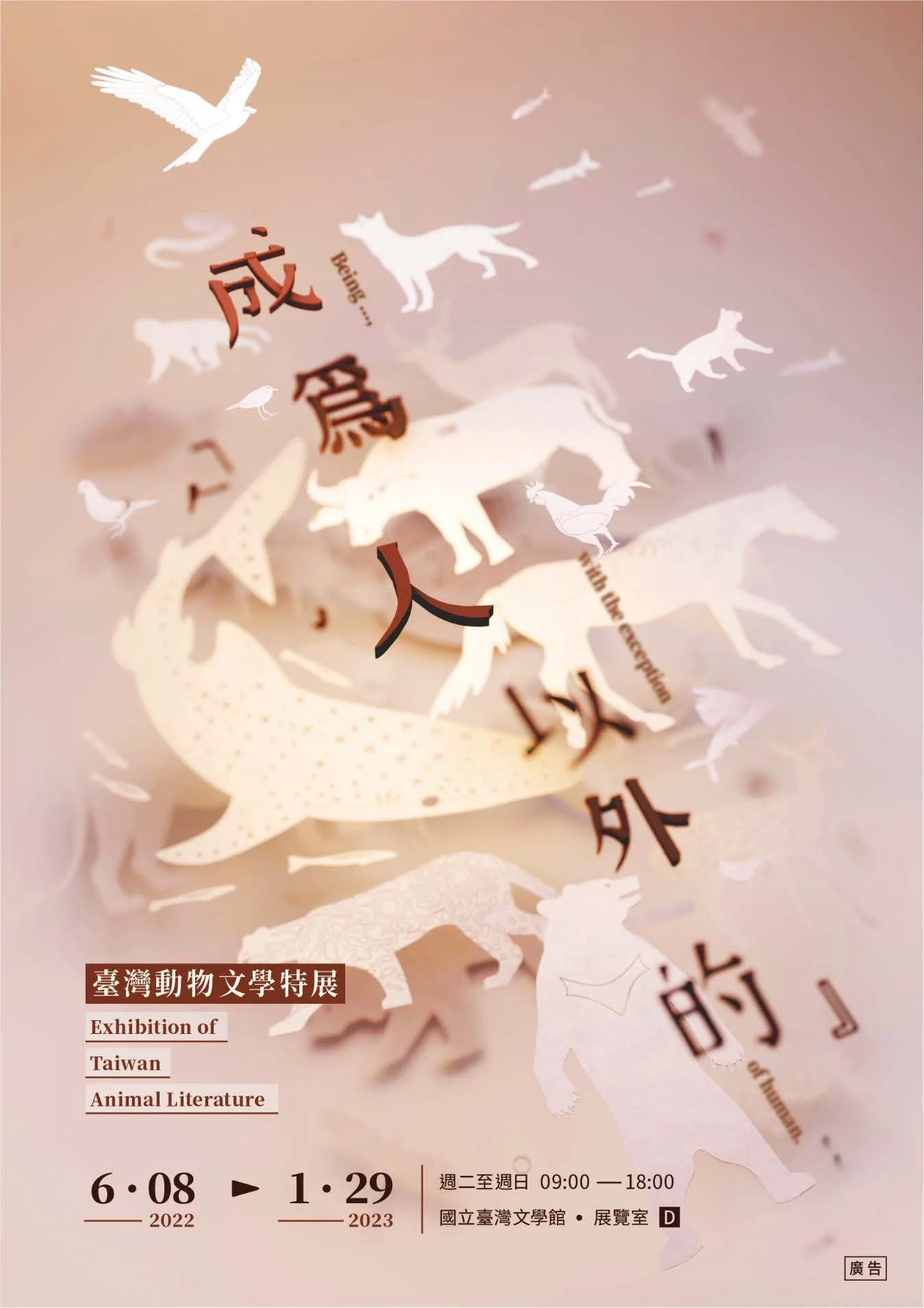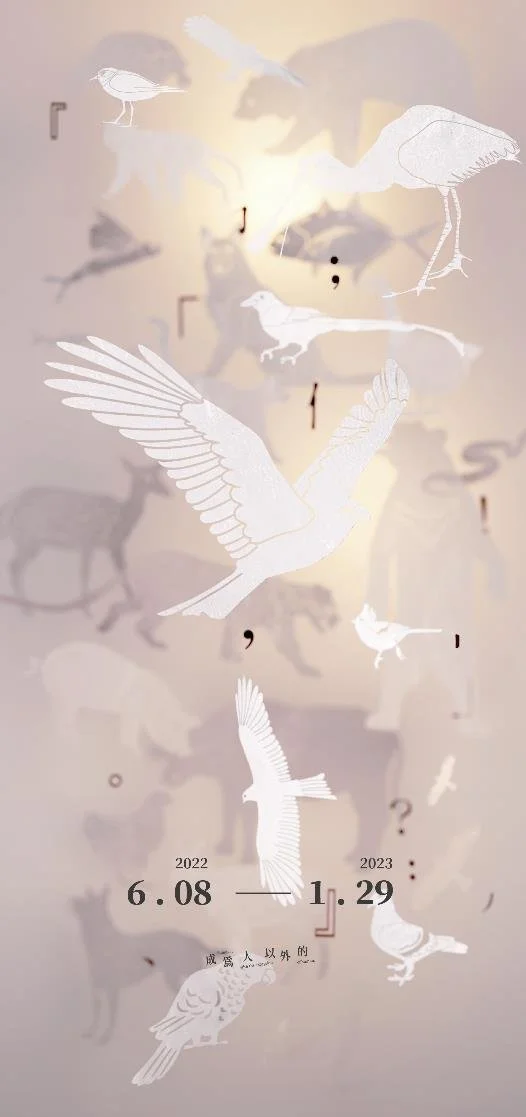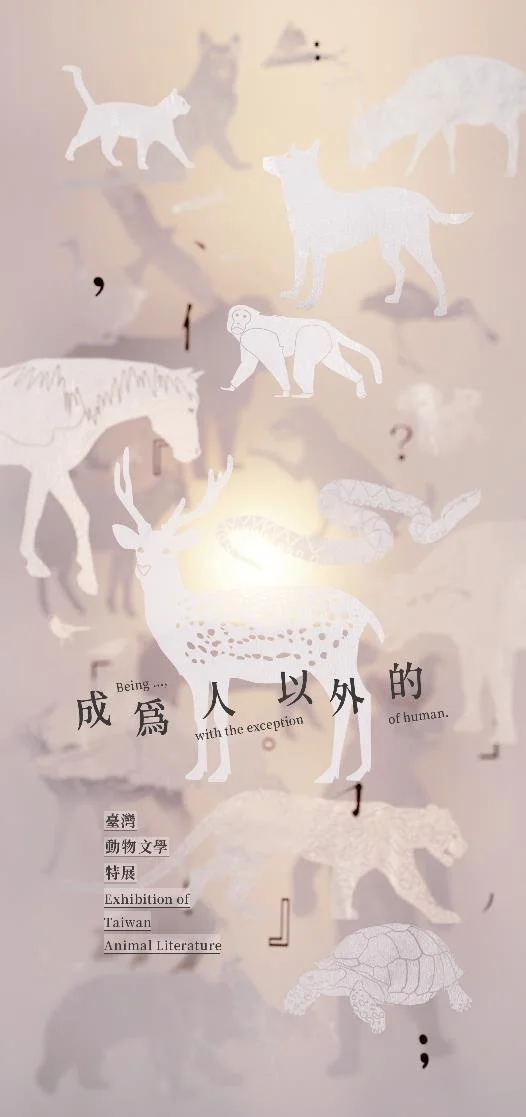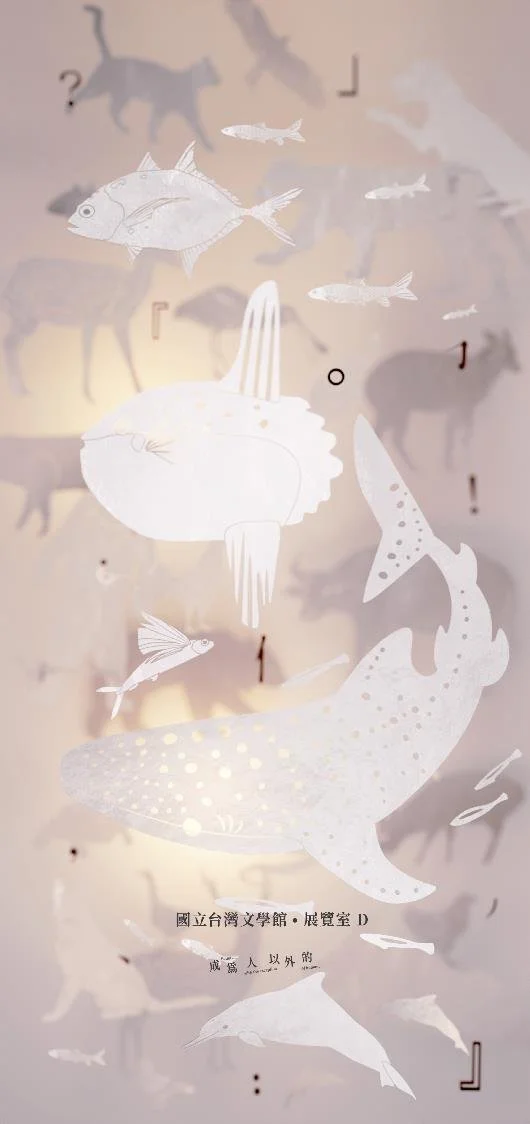
成為人以外的—臺灣動物文學特展
Becoming Other than Human - Taiwan Animal Literature Special Exhibition
本展以「成為人以外的…」書寫命題,映照動物與人在文學裡的各種糾結與關照。並依據角色關係梳理出六大主題:「書寫靈光的眼睛」、「田園時光交響曲」、「變調的工業邏輯」、「獵奇消費修羅場」、「多元價值眾生相」與「動物園裡的凝視」,動物扮演勞役動物、食用動物、戰爭動物、實驗動物、展演動物,乃至當代貓狗萌寵的社會脈絡及現象。
This exhibition uses the title of "becoming something other than human..." to reflect the various entanglements and cares of animals and humans in literature. And based on the role relationship, six major themes were sorted out: "The eyes of writing aura", "Symphony of pastoral time", "Industrial logic of tone shifting", "Sura field of hunting and consumption", "Multiple values of all beings" and "Gaze in the zoo", animals Acting as labor animals, food animals, war animals, experimental animals, performance animals, and even the social context and phenomenon of contemporary cats and dogs.
轉化的敘事與觀看
Transformed Narratives and Viewing
各單元皆設計不同「觀」展情境體驗,轉譯文學手法以呼應動物的視角。如將動物文學摘句,以大量生產的商品包裝載體呈現,講述工業化的經濟動物時代。或刻意讓觀眾以放大鏡或洞眼窺探展牆內裡文句,回應人類看待動物的獵奇視角。或以鏡面折射特性設計「看與被看」的變化展牆,象徵人與動物關係的辯證。
Each exhibition unit is designed with a different situational experience of "viewing" the exhibition, translating literary techniques to echo the perspective of animals. For example, excerpts from animal literature are presented in the form of mass-produced commodity packaging, telling the era of industrialized economic animals. Or deliberately let the audience use a magnifying glass or a hole to peek into the words and sentences inside the exhibition wall, responding to the curious perspective of human beings on animals. Or use the refraction characteristics of the mirror to design the changing exhibition wall of "seeing and being seen", which symbolizes the dialectical relationship between humans and animals.
展場最大亮點為結合古蹟既有拱門的大型紙雕裝置藝術,將文學摘句中提及動物圖像化,呈現時代演變中人與動物的共生群像。呼應展區開頭以動物為主體,展區最後回到臺灣動物文學家;互動畫框內呈現 12 篇不完整的摘句,觀者踏上動物腳印,解鎖對應文句及情境投影,進而細讀作品、認識作家。
The biggest highlight of the exhibition is the large-scale paper sculpture installation art combined with the existing arches of the historic site, which visualizes the mention of animals in excerpts from literature, presenting the symbiotic group portraits of humans and animals in the evolution of the times.
Echoing the beginning of the exhibition area with animals as the main body, the exhibition area returns to Taiwanese animal writers at the end; 12 incomplete excerpts are presented in the interactive picture frame. Viewers step on the animal footprints to unlock the corresponding sentences and situational projections, and then read the works carefully and understand writer.
文字感受立體化
Three-dimensional feeling of text
展覽的角色們是動物、是人。設計策展團隊比較像是角色以外的轉譯者。就像語言翻譯;文學的語言是文字,而展覽的語言是設計。這設計包括視覺、聽覺、觸覺等多重設計體驗。此次的文學性非常強,希望透過體驗式設計,將文學作品轉譯出多重的感受層次。讓觀眾在空間的帶領與動態視覺引導下,能對這次摘選出的文學作品有更多的想像空間與情感連結。
The characters in the exhibition are both animals and people. Design curation teams are more like translators. It’s like language translation; the language of literature is words, and the language of exhibitions is design. This design includes visual, auditory, tactile and other multiple design experiences.
The literary nature of this project is very strong, and we hope that through experiential design, the literary works can be translated into multiple layers of feelings. Under the guidance of space and dynamic visual strategies, the audience can have more imagination space and emotional connection with the literary works selected this time.
動物與人,與我們有最貼近的情感交流,每個人(包括觀者)也都各自擁有屬於個人化的情感體驗,無法用分析或歸類去定調。加上文學是最富有想象力的載體之一,比直接看到的視覺更有想像的空間。我們不希望過度凸顯動物的個別性或特定性,因此以具象的「剪影」來描繪各種動物形態,以「白色」為主色調,把「留白」讓給文字。最後再以「光」打亮動物與文學,讓彼此可以烘托照耀。主視覺的概念也由此而生,這次文學裡所提及的動物相當多元,每一個動物都是主角。
Animals and people have the closest emotional communication with us, and everyone (including the viewer) also has their own personal emotional experience, which cannot be set by analysis or classification. In addition, literature is one of the most imaginative carriers, and it has more room for imagination than direct vision.
We don't want to overemphasize the individuality or specificity of animals, so we use figurative "silhouettes" to describe various animal forms, use "white" as the main color, and give "blank space" to the text. Finally, "light" is used to illuminate animals and literature, so that they can complement each other and shine. The concept of key vision is also born from this. The animals mentioned in this literature are quite diverse, and each animal is the protagonist.
結合古蹟既有拱門的大型紙雕裝置藝術,將文學摘句中提及動物圖像化,呈現時代演變中人與動物的共生群像。
Combined with the large-scale paper sculpture installation art of the existing arches of the historic site, the animals mentioned in the literary excerpts are visualized, presenting the symbiotic group images of humans and animals in the evolution of the times.
以動物為鏡
mirror of animals
三個空白稿紙的螢幕,觀眾靠近會有文字摘句顯現,並將觀眾轉化為動物形象,從「人」的視角跳脫,也就是「成為人以外的……」。由展覽統籌黃宗潔挑選 8 種有差異性動物的文學作品,包含禽類的麻雀、爬蟲類的烏龜、昆蟲蜻蜓、兩棲類青蛙、還有哺乳動物雪豹、兔子等。
On the three screens of blank manuscript paper, excerpts of text will appear when the viewer approaches, transforming the viewer into an animal image, escaping from the perspective of "human", that is, "becoming something other than human...". The exhibition coordinator Huang Zongjie selected 8 different animal literatures, including bird sparrows, reptile turtles, insect dragonflies, amphibian frogs, mammals snow leopards, rabbits, etc.
藉由體感技術即時將觀眾轉化為 3D 素描版動物形貌,使民眾跳脫「人」的視角,換位「成為人以外的」某種動物,展開各單元敘事。
Using somatosensory technology, the audience is transformed into a 3D sketch version of an animal in real time, allowing the public to escape from the perspective of a "human" and transpose to "become an animal other than a human" to unfold the narrative of each exhibition unit.
批判式物件 (Critical objects):將動物文學摘句,以大量生產的商品包裝載體呈現,講述工業化的經濟動物時代。
Critical objects: Excerpts from animal literature are presented in the form of mass-produced commodity packaging, telling the story of the era of industrialized economic animals.
刻意讓觀眾以放大鏡或洞眼窺探展牆內裡文句,回應人類看待動物的獵奇視角。
Deliberately let the audience use a magnifying glass or a hole to peek into the words and sentences inside the exhibition wall, responding to the curious perspective of human beings on animals.
以鏡面折射特性設計「看與被看」的變化展牆,象徵人與動物關係的辯證。
The changing exhibition wall of "seeing and being seen" is designed with the refraction characteristics of the mirror, which symbolizes the dialectical relationship between humans and animals.
呼應展區開頭以動物為主體,展區最後回到臺灣動物文學家;互動畫框內呈現 12 篇不完整的摘句,觀者踏上動物腳印,解鎖對應文句及情境投影,進而細讀作品、認識作家。
Echoing the beginning of the exhibition area with animals as the main body, the exhibition focus returns to Taiwanese animal writers at the end; 12 incomplete excerpts are presented in the interactive picture frame. Viewers step on the animal footprints to unlock the corresponding sentences and situational projections, and then read the works carefully and understand writer.
參與式設計:如果有機會成為人以外的,你想成為什麼動物呢?
Participatory Design: If given the chance to be something other than a human, what animal would you want to be?
如果有機會成為人以外的,你想成為什麼動物呢?―透過行動裝置參與投票。
If you had the chance to be something other than human, what animal would you want to be? ―Participate in voting through mobile devices.
如果有機會成為人以外的,你想成為什麼動物呢?―民眾票選結果,於螢幕上即時以資訊圖像呈現。
If you had the chance to be something other than human, what animal would you want to be? ―The results of popular votes are displayed on the screen in real time with information images.
當民眾拿起書架上的動物文學,下方層板上出現動物圖像文本 (typographic excerpts)。
When the visitor picks up the animal literature on the bookshelf, typographic excerpts appear on the shelf.
動物圖像文本 (typographic excerpts) 設計。
The designs of animal image text (typographic excerpts).
展區最後通往出口的廊道,以動物文學大事記作結。
The corridor leading to the exit at the end of the exhibition area ends with the memorabilia of animal literature.
展覽主視覺設計
Exhibition key visual design
每個動物在不同人心中具備不同情感。我們盡量保持開放,而非凸顯特定對象。主視覺以 3D 剪影製作,透過焦段變化與運鏡,讓每次對焦的動物不同,透過不同焦段每一種動物都是主角,同時呼應策展的轉譯文學手法及視觀點的轉換。光的基底色調較安靜疏離,希望不要給予觀眾太主觀或企圖反思檢討的氛圍,而是了解、關愛、行動,以暖色調呈現一個面向希望的閱讀氣氛。
Different animal evokes different emotions in different people. We try to keep it open and not highlight specific objects. The main visual is designed with 3D silhouettes. Through the change of focal length and the movement of the mirror, the animals in focus are different each time. Through different focal lengths, each animal is the protagonist.
At the same time, such visual strategy echoes the curatorial literary translation technique and the transformation of perspective. The base tone of light is quiet and alienated. We hope that the audience will not be too subjective or try to reflect and review the atmosphere, but understand, care, and act, and present a hope-oriented reading atmosphere with warm tones.
媒體報導
【UDN 500 輯】向動物學謙卑,台文館《成為人以外的》特展登場:六大展區收斂80位文學作家,高5公尺織品藝術邀眾人共創
【MOT TIMES 明日誌】台文館《成為人以外的》特展登場!以六大主題、互動式投影、紙雕藝術等爬梳台灣百年動物文學





























































